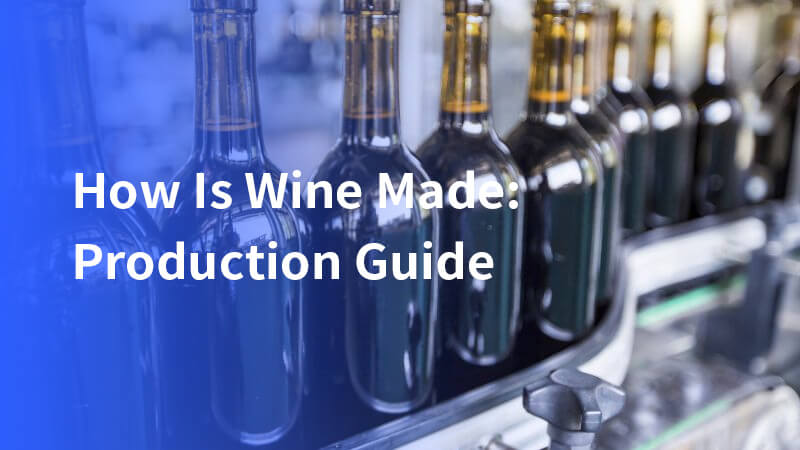How is wine made? The process of wine production begins with grape harvesting, followed by crushing, fermentation, and aging. Quality control is crucial during bottling and corking to prevent spoilage and ensure optimal aging conditions.
After labeling, the wine is prepared for distribution, maintaining a meticulous balance of science, technique, and tradition to achieve exceptional quality.
Now let’s talk about how to make wine in the factory.
Wine-making equipment for industrial-scale production
For those venturing into wine production on an industrial scale, essential equipment is pivotal in ensuring quality and efficiency throughout the process.
First and foremost, large-scale fermentation vessels are indispensable. These can range from stainless steel tanks to specialized fermenters tailored to batch sizes. These vessels are equipped to handle the volume and intricacies of commercial fermentation processes.
In addition to fermenters, robust airlock systems are employed to regulate gas exchange during fermentation, safeguarding wine quality by preventing oxygen ingress.
Precise monitoring of wine’s progress is facilitated by industrial-grade hydrometers, pivotal in gauging specific gravity to determine optimal fermentation completion and bottling readiness.
Efficient transfer of wine between vessels necessitates advanced siphoning systems with durable tubing, ensuring seamless movement throughout production stages. Precision sampling is facilitated by automated wine thieves, streamlining quality checks.
Complementary to these essentials, mechanized wine presses excel in extracting juice from diverse fruits, while crushers efficiently reduce them for optimal pressing.
Sealing finished wine bottles mandates automated corking systems, guaranteeing product integrity and longevity. Cleaning and sterilizing bottles are expedited by industrial bottle washers, maintaining hygienic standards.
Critical to maintaining fermentation integrity, temperature, and humidity control systems ensure optimal environmental conditions, pivotal in fostering consistent and superior wine quality.
These specialized equipment pieces form the backbone of industrial winemaking, ensuring each batch meets stringent quality standards while optimizing production efficiency.
Grape harvesting
Harvesting grapes plays a pivotal role in wine production, marking the culmination of year-long efforts. Grapes are picked at peak ripeness, typically from August to November in the Northern Hemisphere and March to August in the Southern Hemisphere. Timely harvesting is crucial for ensuring optimal wine quality.
The process involves either hand-picking or machine harvesting. Hand-picking offers meticulous grape selection, favored for premium wines despite its labor intensity.
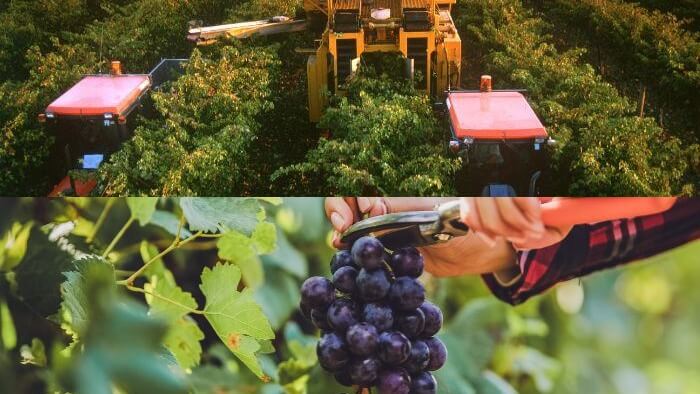
Machine harvesting, though faster, may lead to grape damage. Post-harvest, grapes are swiftly transported to the winery for processing, emphasizing precision and coordination in the winemaking process.
Crushing and pressing grapes
After harvesting, grapes undergo sorting and crushing at the winery to extract their juice, a pivotal step in wine production.
Crushing breaks the grape skins to release the juice, crucial for subsequent fermentation. This process can be performed manually or using mechanical crushers, each method carefully chosen for efficiency and grape quality.
In some instances, winery staff may opt to include grape stems during crushing, believing it enhances the wine’s tannic structure.
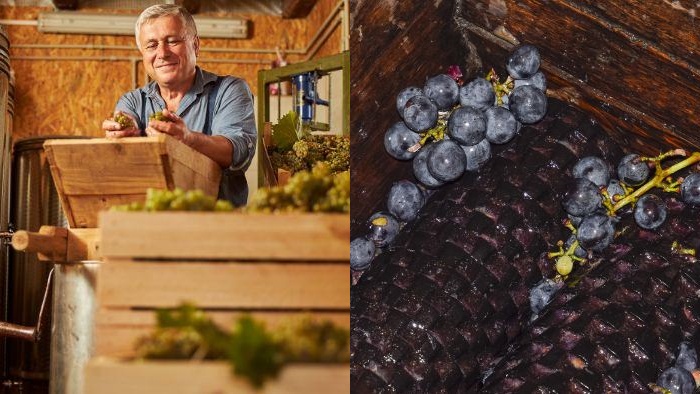
However, removing stems reduces the risk of unwanted flavors. Post-crushing, the juice undergoes pressing to separate it from grape solids. This pressing step, executed using various press types like basket or bladder presses, ensures maximum juice extraction, maintaining the wine’s quality and flavor profile.
Wine fermentation
Fermentation is a crucial stage in crafting wine, where flavors and quality are shaped.
Once grape juice is separated from solids, yeast is introduced, a pivotal step conducted by winery staff. Yeast plays a vital role, in converting sugars into alcohol, with different strains offering unique flavor and aroma profiles carefully selected by winemakers.
The yeast-infused juice undergoes fermentation, monitored meticulously by factory personnel. As carbon dioxide bubbles form and release, temperature, humidity, and pH levels are closely observed to ensure optimal conditions throughout the process.

Over weeks or months, depending on desired characteristics, fermentation progresses, enhancing wine’s flavor and aroma complexity, a testament to the skilled craftsmanship of winery operators.
Postfermentation processes
Post-fermentation processes play a critical role in ensuring the production of top-quality wines.
Following the initial fermentation, during which yeast converts sugar into alcohol, the wine retains sediment and impurities that necessitate removal. This crucial step, known as racking, involves transferring the wine into a pristine container, leaving sediment behind. This meticulous process is essential for achieving a clear and visually appealing wine.
After racking, additional procedures can further refine the wine’s flavor and texture. One such procedure is malolactic fermentation, where bacteria convert malic acid into lactic acid.
Another post-fermentation technique commonly employed is aging. During aging, wines are stored in oak barrels or stainless steel tanks for several months, and sometimes years. This extended period allows the wine to mature, developing nuanced flavors and aromas, while also softening its tannins and acidity.
Implementing malolactic fermentation
Malolactic fermentation is a pivotal process that follows the initial alcoholic fermentation, involving the transformation of malic acid into lactic acid by bacteria. This not only reduces the wine’s acidity but also introduces a desirable buttery and creamy flavor, particularly enhancing wines like Chardonnay.
The bacteria essential for malolactic fermentation are typically found in winery environments, and winemakers may introduce them to ensure complete malic acid conversion. Precise control over wine temperature and pH levels is crucial during this phase, as excessive heat or acidity can inhibit bacterial activity and stall fermentation.
The duration of malolactic fermentation varies from several weeks to months, contingent upon the wine type and production conditions.
A time-honored tradition of aging wine
Wine, an integral part of human civilization spanning millennia, has captivated palates and cultures alike. From ancient civilizations like Egypt to modern-day revelries, wine’s allure lies not only in its robust flavors but also in its transformative journey through time. Central to this journey is the art of aging wine, a practice steeped in history that continues to shape today’s vibrant wine industry.
Aging wine involves the meticulous storage of wine in a carefully controlled environment over an extended period. Its origins trace back to antiquity, notably embraced by the ancient Romans who stored their wines in clay amphorae buried underground. Across the Mediterranean, the Greeks too valued the aging process, believing it enhanced the wine’s character and depth.
During the medieval period, wine aging expanded as trade flourished, enabling wines to traverse continents. Wooden barrels emerged as favored vessels, offering a stable environment conducive to maturation. Innovations in barrel-making, such as oak and chestnut, imparted distinct nuances to wines, enriching their complexity.
Today, aging wine remains a cornerstone of winemaking. Many esteemed wineries nurture their wines for months or even years before release, harnessing advancements in technology to regulate cellar conditions rigorously. Despite modern refinements, the essence of aging wine endures unchanged, underpinning the production of premium wines globally.
How to successfully age wine
Aging wine is a gradual, intricate process that demands patience and precision, beginning with the selection of premium grapes. These grapes undergo meticulous crushing and fermentation to form the base wine, which is then transferred into barrels or bottles to commence its aging journey.
During aging, the wine undergoes a series of chemical transformations that refine its flavor profile and texture. Over time, the harsh tannins mellow, contributing to a smoother mouthfeel and enhanced drinkability. Concurrently, new layers of flavors and aromas develop, enriching the wine’s complexity beyond its initial bottling.
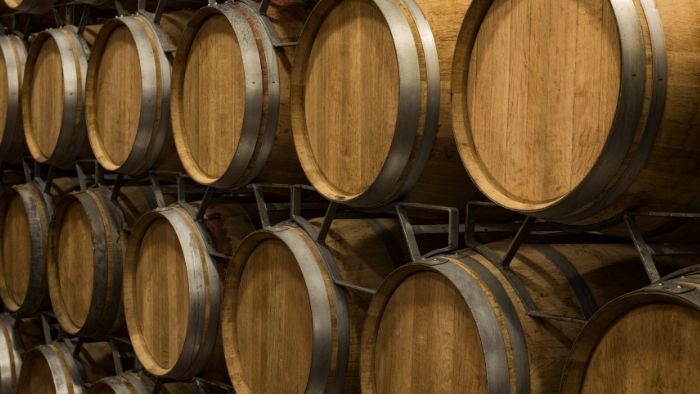
However, not all wines are suited for extended aging. While some varieties are best enjoyed young, others, such as robust reds like Cabernet Sauvignon and Merlot, benefit from years or even decades of maturation. The key lies in understanding each wine’s potential and optimal aging conditions.
Patience is paramount in aging wine. It may take years, sometimes decades, for a wine to reach its peak. Proper storage is crucial throughout this process, maintaining a cool, dark environment with consistent temperature and humidity levels.
Storing bottles horizontally ensures the cork remains moist, preventing premature oxidation and preserving the wine’s integrity until it’s ready to be savored.
Typical aging times for various wines
Understanding the optimal aging times for different wines is crucial to appreciating their full potential.
- Cabernet Sauvignon: 4 to 20 years Cabernet Sauvignon, known for its robust tannins and deep flavors, benefits from extended aging to soften these tannins and develop complex, mature flavors.
- Chardonnay: 2 to 6 years Chardonnay, a versatile white wine, typically undergoes a shorter aging period to preserve its fresh fruit flavors and balanced acidity. Longer aging can add depth and richness.
- Chenin Blanc: 4 to 30 years Chenin Blanc, with its high acidity and potential for sweetness, ages gracefully over decades, evolving from crisp and vibrant to honeyed and complex.
- Classified Bordeaux: 8 to 25 years Bordeaux blends, crafted from Cabernet Sauvignon, Merlot, and other grapes, require substantial aging to integrate their bold tannins and reveal layers of nuanced flavors.
- Merlot: 2 to 10 years Merlot, known for its softness and fruity character, benefits from moderate aging to enhance its texture and develop secondary aromas like tobacco and leather.
- Pinot Noir: 2 to 8 years Pinot Noir, celebrated for its delicate flavors and aromas, matures relatively quickly compared to other reds, evolving from bright fruitiness to earthy complexity.
- Riesling: 2 to 30 years Riesling, with its high acidity and diverse styles from dry to sweet, ages remarkably well, developing petrol notes and complex honeyed flavors over decades.
- Vintage Ports: 20 to 50 years Vintage Ports, made from robust red grapes, are fortified and age slowly in barrels before bottling. They require extensive aging to soften and integrate their powerful structure.
- Zinfandel: 2 to 6 years Zinfandel, known for its bold fruit flavors and peppery spice, benefits from short to moderate aging to maintain its vibrant fruit character while softening its tannins.
Bottling and labeling your own wine
Embarking on the journey of bottling and labeling your own wine is a gratifying and enjoyable endeavor!
The first step in bottling wine is ensuring it has completed its fermentation and aging process. Once your wine is ready, carefully transfer it into clean, sterilized bottles using a siphon. Leave some headspace to accommodate the cork.
Next, cork the bottles securely. Purchase appropriate corks from a winemaking supplier and use a corker to press them firmly into place. Store the bottles upright for several days to allow the corks to expand and create a tight seal before laying them horizontally.
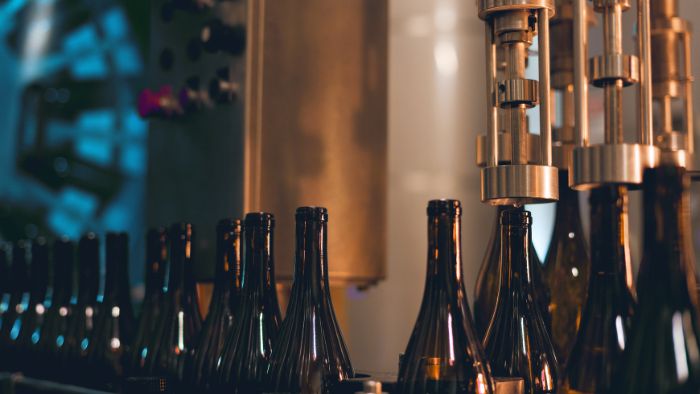
With your wine bottled, it’s time to design and apply the labels. Select a label design that reflects the character of your wine. You can create your own using software, or enlist a graphic designer for a professional touch. Include essential details such as the wine’s name, vintage year, and any additional information you wish to convey.
Lastly, apply the labels neatly to the bottles using a label applicator, glue stick, or double-sided tape. Ensure they are straight and even for a polished appearance that showcases your craftsmanship. If you are a wine manufacturer, then a large labeling machine is a good choice. LMS can provide you with high-quality labeling equipment and also has a special wine labeling solution.
Conclusion
How is wine made? The process of crafting wine involves meticulous steps from grape harvesting to bottling and labeling. Each stage, from fermentation to aging, is a blend of artistry and science aimed at producing exceptional quality.
Whether for personal enjoyment or industrial-scale production, understanding these processes ensures that each bottle reflects the dedication and craftsmanship of its creators. Cheers to the timeless tradition of winemaking and the diverse flavors it brings to the table!
If you are a new wine manufacturer and want to produce wine on a large scale, we also provide you with information of the machines used in the wine production process and their functions:
Necessary machines
| Step | Machine | Function |
| Harvesting | Grape harvester | Mechanically harvest grapes |
| Sorting | Grape sorter | Remove defective grapes, leaves, and other debris |
| Crushing | Crusher | Crush grapes and release juice |
| Pressing | Press | Extract juice from grape skins |
| Fermentation | Fermentation tank | Ferment grape juice into wine |
| Aging (optional) | Oak barrel | Age wine in oak barrels to impart vanilla, spice, and other flavors |
| Filtering | Filter | Remove impurities from wine |
| Bottling | Bottling machine | Fill wine into bottles |
| Corking | Corking machine | Seal wine bottles with corks or other stoppers |
| Labeling | Labeling machine | Apply labels to wine bottles |
Additional machines
| Machine | Functions |
| Rotary fermenter | Mix grape skins with grape juice during fermentation to extract more color and flavor |
| Freezer | Control the temperature during wine fermentation |
| Centrifuge | Clarify wine by removing yeast and other impurities |
| Stabilizer | Prevent wine from sedimenting or discoloring in the bottle |
| Sweetener | Add sugar, acid, or other ingredients to wine |
